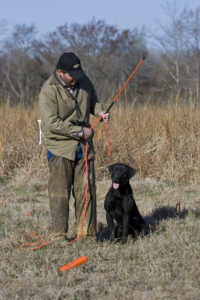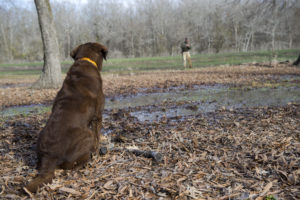Those of us who have spent years training our own dogs, or who have trained dogs professionally, often assume that everybody shares our view of the commands a well-trained dog should know.
When it comes to retrievers, it’s even easier to make assumptions. Retrievers are such intelligent animals that the spectrum of things you can train them to do range from sitting on command to cooking a six-course meal and mixing a dry martini. But does your dog really need all those commands to be an effective hunting companion?
The answer is yes … and no. Yes, if you want nothing less than a finished dog. But no, if, like the majority of you reading this, you just want a buddy who will keep you company in the blind, fetch your birds, and perform a few functional commands reliably and well.
To that end I interviewed a friend of mine, Cal Horner, a fellow Montanan and a professional retriever trainer for 24 years. Getting him to decide on a handful of essential commands wasn’t easy — after all, he’s spent decades training dogs to obey a whole spectrum of commands, not just one or two. But I persisted, and eventually he came around. Let’s face it: If you have a young dog who’s ready to hunt, you can teach it what it needs to know to get started and work on the rest of the stuff later.
The Two Commands
Horner suggested two commands:
1. The recall command
2. The whistle sit
Both give you control of your dog in the field and will go a long way toward developing a functional relationship with your dog on a hunt. For the record, he’s also assuming that your dog is conditioned to both an electronic collar and gunfire. Let’s start with the recall command.
The Recall Command
“There are several ways to teach that,” Horner says. “If he’s collar conditioned, you can say ‘here,’ nick him, then say ‘here’ again. Give the command, give the correction, and then repeat the command.”
You can also use the traditional method of putting your dog on a lead.
“Put a cord on them,” he says, “and let them walk around and sniff over here and over there, and then give him your command and jerk on the lead to encourage him to come in.”
As with all commands, once the dog is reliably performing at one level, you move him incrementally to the next. Here’s how Horner suggests that should work. Let’s say you’re beginning with your pup on a lead. Perform the command enough times, over enough days, that the dog starts to anticipate it and moves toward you after the command. Next, use a longer lead. If you’ve been using a 25-foot lead, switch to a 50-footer. Finally, remove the leash and switch to an electronic collar. Give him the command with the command/nick/command sequence outlined above, and when he’s obeying that every time, start adding distractions — other dogs, a different training area, whatever. When he’s good with that, he’s good to go.
The Whistle Sit
Teaching the whistle sit is even easier. “For a lot of dogs, when you call them to you, they’ll sort of automatically sit,” Horner says. “If he does that, you can tell him to sit and then praise him or give him a treat for a reward. Another thing you can do with a young dog is to simply pull up on his leash. Give him the command (the whistle), pull up on his leash, and to get away from the pulling he’ll sit.”
As with the whistle recall, once your dog is sitting on command, you should progress to reinforcing the command with a nick from the collar, giving him the whistle-sit command at a gradually increasing distance, and finally adding distractions.
However you approach your dog’s training, the main thing is to be consistent, Horner says.
Although I suggested that we cover just a couple of essential commands, Horner wanted to add one more: the long sit. In obedience training, this is known as “stay.” You can teach your pup the long sit by first teaching it to sit on a whistle (or voice) command, then making the dog stay sitting until you release it. As with all training sequences, make it easy for your dog at first and then gradually increase the difficulty.
What's next?
You now have a dog that is ready to hunt. Are you finished?
Nope. Although these might be the last commands your dog ever learns, you still have to reinforce them in the field.
“The real world is always different than what it is in your training yard,” Horner says. “You get out there and there’s distractions and this and that, maybe your dog runs into a porcupine. That’s when your whistle sit would really be worth something, if he started to go after one.
“So you keep after it, don’t cut your dog any slack. And eventually, you and your dog get to where you both want to be.”








